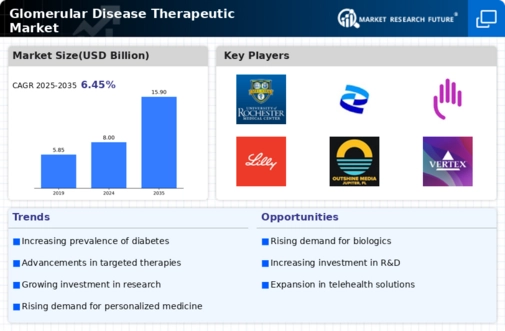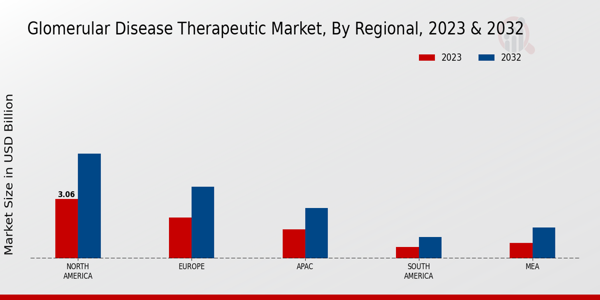Market Growth Projections
The Global Glomerular Disease Therapeutic Market Industry is poised for substantial growth, with projections indicating a market value of 8 USD Billion in 2024 and an anticipated increase to 15.9 USD Billion by 2035. This growth trajectory suggests a compound annual growth rate of 6.45 percent from 2025 to 2035, reflecting the increasing demand for effective treatments and the ongoing advancements in therapeutic technologies. The market's expansion is likely to be driven by a combination of rising disease prevalence, innovative research, and supportive regulatory frameworks.
Regulatory Support for New Therapies
Regulatory agencies are increasingly supporting the development of new therapies for glomerular diseases, positively impacting the Global Glomerular Disease Therapeutic Market Industry. Initiatives such as expedited review processes and orphan drug designations are designed to facilitate the introduction of innovative treatments. This regulatory environment encourages pharmaceutical companies to invest in research and development, knowing that their products may receive quicker market access. As a result, the market is likely to see a surge in new therapeutic options, aligning with the projected growth trends in the coming years.
Advancements in Therapeutic Technologies
Technological advancements in the development of therapies for glomerular diseases are pivotal for the Global Glomerular Disease Therapeutic Market Industry. Innovations such as targeted biologics and gene therapies are emerging, offering new avenues for treatment. For example, monoclonal antibodies and small molecule inhibitors are being explored for their efficacy in treating various glomerular conditions. These advancements not only enhance treatment efficacy but also improve patient outcomes, thereby driving market growth. The anticipated market value of 15.9 USD Billion by 2035 reflects the potential impact of these technological innovations on therapeutic options.
Growing Awareness and Screening Programs
Rising awareness regarding glomerular diseases and the importance of early diagnosis is influencing the Global Glomerular Disease Therapeutic Market Industry. Public health campaigns and screening programs are being implemented to educate populations about risk factors and symptoms. This proactive approach encourages individuals to seek medical attention sooner, leading to earlier intervention and treatment. As more patients are diagnosed, the demand for effective therapies is likely to increase, thereby contributing to market growth. The integration of awareness initiatives into healthcare systems may further enhance the market's trajectory.
Rising Prevalence of Glomerular Diseases
The increasing incidence of glomerular diseases globally drives the Global Glomerular Disease Therapeutic Market Industry. Conditions such as diabetic nephropathy and focal segmental glomerulosclerosis are becoming more prevalent, particularly in aging populations. For instance, the prevalence of diabetic nephropathy is estimated to be around 30 percent among diabetic patients. This growing patient population necessitates the development and availability of effective therapeutic options, contributing to the market's expansion. As the market is projected to reach 8 USD Billion in 2024, the demand for innovative treatments is expected to rise significantly.
Increased Research and Development Investments
The Global Glomerular Disease Therapeutic Market Industry benefits from heightened investments in research and development by pharmaceutical companies and academic institutions. This trend is fueled by the urgent need for novel therapies to address unmet medical needs in glomerular diseases. Governments and organizations are also providing funding for research initiatives, which further stimulates innovation. The projected compound annual growth rate of 6.45 percent from 2025 to 2035 indicates a robust pipeline of new therapies that could significantly alter treatment landscapes and improve patient care.























Leave a Comment